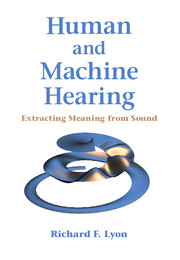Book contents
- Frontmatter
- Dedication
- Contents
- Foreword
- Preface
- Part I Sound Analysis and Representation Overview
- Part II Systems Theory for Hearing
- 6 Introduction to Linear Systems
- 7 Discrete-Time and Digital Systems
- 8 Resonators
- 9 Gammatone and Related Filters
- 10 Nonlinear Systems
- 11 Automatic Gain Control
- 12 Waves in Distributed Systems
- Part III The Auditory Periphery
- Part IV The Auditory Nervous System
- Part V Learning and Applications
- Bibliography
- Author Index
- Subject Index
- Plate section
10 - Nonlinear Systems
from Part II - Systems Theory for Hearing
Published online by Cambridge University Press: 28 April 2017
- Frontmatter
- Dedication
- Contents
- Foreword
- Preface
- Part I Sound Analysis and Representation Overview
- Part II Systems Theory for Hearing
- 6 Introduction to Linear Systems
- 7 Discrete-Time and Digital Systems
- 8 Resonators
- 9 Gammatone and Related Filters
- 10 Nonlinear Systems
- 11 Automatic Gain Control
- 12 Waves in Distributed Systems
- Part III The Auditory Periphery
- Part IV The Auditory Nervous System
- Part V Learning and Applications
- Bibliography
- Author Index
- Subject Index
- Plate section
Summary
These results indicate that cochlear mechanics incorporates an essential nonlinearity, so that linear superposition for neighboring spectral components does not apply even at low sound levels.
—“Auditory nonlinearity,” J. L. Goldstein (1967)In this chapter, we relax the constraints of linearity and time invariance. We let systems be time varying and level dependent as a way to incorporate some nonlinear phenomena in hearing. We also touch on concepts of nonlinear system description, such as the Volterra series, that make connections between measurements on linear and nonlinear systems, and on some examples of nonlinear systems.
Nonlinear systems cannot be completely characterized by their responses to sine waves; nevertheless, they are often described in terms of their responses to sine waves of various amplitudes, and to pairs of sine waves, using several different kinds of measurements and plots. We compare several of these in terms of how the nonlinearities manifest themselves in the plots.
We also discuss how nonlinearities can complicate sampling and aliasing considerations.
Nonlinear system responses in hearing are typically described relative to a characteristic frequency (CF), the frequency at which the system is most responsive, or most sensitive, at low levels—the frequency with the lowest threshold. It is analogous to the center frequency of a bandpass filter, but the frequency of greatest response or gain can change with level, so the linear filter analogy needs to be used carefully. For any place of measurement in the cochlea or the auditory nervous system, there may be a well-defined CF, but that CF is typically not the frequency of greatest response, except at very low levels.
Volterra Series and Other Descriptions
The output of a linear system is its input convolved with its impulse response. If a system is not too far from linear, then using a linear convolution model plus some correction terms can be a useful description. The Volterra series is such a description (and the Wiener series is another, closely related, which we will not discuss).
- Type
- Chapter
- Information
- Human and Machine HearingExtracting Meaning from Sound, pp. 189 - 201Publisher: Cambridge University PressPrint publication year: 2017
- 13
- Cited by

